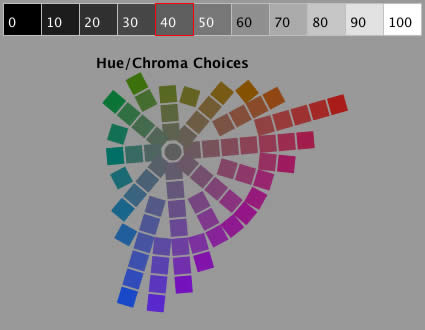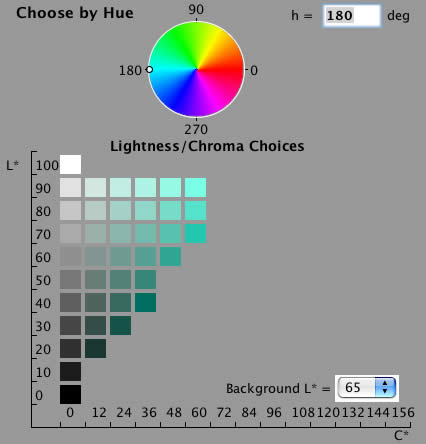 |
| COLOR TOOL EXAMPLE: COLOR SPACE VISUALIZATION One good use for the Color Tool
is to get an overview of the perceptual organization of the colors available on a
display. The “Choose by Hue” and “Choose
by Lightness” color selection panels let us look at representative samples of all
of the colors in the 3D gamut of a color display. The panels present two different
planar slices through the 3D volume, displayed in perceptually-meaningful, uniformly-spaced
coordinates. Users who don’t have extensive training or experience with applied
color perception (and maybe even a
few who do have color training) can quickly see a few things about the visual
possibilities supported by the display by browsing
through this space. For example, the range of saturations in the display’s gamut depends on both the hue and the lightness. To see the dependence on lightness, go to the “Choose by Lightness” color selection panel and click on 100, 90, 80, …, 0 to view each page of hues and saturations. Not only does the maximum saturation (C*) on the page vary with lightness (L*), but the hue that has the maximum varies as well. At high L* the maximum C* is in the greens. At lower L* it shifts to the reds and blues.
At the highest and lowest L* values none of the colors is very saturated. Now select L* = 30 for the color selection panel and take a look at how background lightness influences the saturations. First select a high background L*, using the box on the left. Notice how this decreases the saturation of the darker colors. Now select a low background L*. The dark colors’ saturations (and brightnesses) become much greater. The “Choose by Hue” color selection panel is useful for revealing other aspects of the gamut. The pages for some hues (e.g., 5 deg) have “pointed” profiles, i.e., the maximum saturation falls off rapidly at lightnesses above and below the optimum.
Others (e.g., 180 deg) have more “rounded” profiles. Maximum saturation is achieved over a range of lightnesses.
This panel also allows inspection of the appearances of the available C* at a constant L* (rows) and the available L* at a constant C* (columns).
|
|
Related Topics:
|



